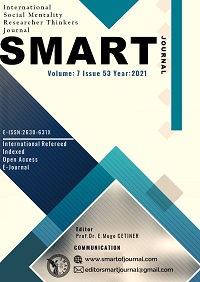Author :
Abstract
İslami edebiyatlarda, On Vezir Hikâyesi olarak da bilinen Bahtiyâr-nâme, Türk edebiyatında XIV. yüzyıldan itibaren görülür. Manzum veya mensur olarak kaleme alınan bu eserlere Sindbad-nâme'nin kaynaklık ettiği kabul edilir. Manzum olarak kaleme alınan Bahtiyâr-nâmelerden bir tanesi, bugün İstanbul Arkeoloji Müzesi Kütüphanesi'nde kayıtlıdır. Eser, Ömer b. Yahya Beg b. Mir-i ‘âlem’e aittir. Mesnevi nazım şeklinin özelliklerini gösteren eserde, yer yer gazel nazım şekliyle yazılmış şiir parçaları da yer alır. Eserin tamamı, 2429 beyittir. Haramiler tarafından büyütülen Bahtiyâr’ın hükümdar Âzâdebaht ile tanışması, onun yanında devlet görevine alması, bir gece hükümdarın tahtında uyuması ve bu hâlde hükümdar tarafından yakalanması üzerine idamını geciktirmek amacıyla her gün duruma uygun bir hikâye anlatması eserin olay halkalarını oluşturur. Eser, edebî açıdan olduğu kadar dil ve imla özellikleri açısından da incelenmeye değerdir. Bu çalışmada, İstanbul Arkeoloji Müzesi kütüphanesinde kayıtlı olan Bahtiyâr-nâme nüshası; fiziksel özellikleri, müellifi, ismi, yazılma sebebi, yazıldığı dönem, dil-imla özellikleri, şekil özellikleri, beyit sayısı ve bölümleri gibi başlıklar altında incelenecektir.
Keywords
Abstract
In Islamic literature, Bahtiyar-nâme, also known as the Story of the Ten Viziers, is the seen from the turn of the XIV. century. Sindbad-nâme is considered to be the source of these works written in verse or prose. One of the Bahtiyâr-nâmes written in verse is today registered in the Library of the Istanbul Archeology Museum. The work belongs to Omar b. Yahya Beg b. Mir-i ‘âlem. In the work, which shows the characteristics of mesnevi verse, there are also parts of poetry written in ghazal verse. The entire work consists of 2429 couplets. The fact that Bahtiyar, who was brought up by the thieves, met the ruler Âzâdebaht, took him to a state job with him, slept on the throne of the ruler one night, and in this state, telling a story every day in order to delay his execution after he was caught by the ruler, constitutes the event circles of the work. The work is worth examining in terms of language and orthographic features as well as in terms of literature. In this study, the copy of Bahtiyâr-nâme registered in the library of the Istanbul Archeology Museum; It will be examined under titles such as its physical features, author, name, reason for writing, the period in which it was written, language-spelling features, morphological features, number of couplets and sections.
Keywords
- Ateş, Ahmet, (1948), Sindbad-nâme, İstanbul, MEB Basımevi.
- Ateş, Ahmet, (1948), Sindbad-nâme, İstanbul, MEB Basımevi.
- Çelebioğlu, Amil, (1999), Türk Edebiyatında Mesnevi (XV. yy’a Kadar), İstanbul, Kitabevi.
- Çelikel, Hava, (2019), Fedâî’nin “Bahtiyâr-nâme” Eserinin Dil-Üslup Açısından İncelenmesi, Kars, T.C.Kafkas Üniversitesi Sosyal Bilimler Enstitüsü Çağdaş Türk Lehçeleri ve Edebiyatları Anabilim Dalı Azerbaycan Türkçesi ve Edebiyatı Bilim Dalı Yayımlanmamış Yüksek Lisans Tezi.
- Daş, Ayşe, (2021), İstanbul Arkeoloji Kütüphanesi 1022 Numarada Kayıtlı Bahtiyâr-nâme Nüshası,Akademide Üç Kuşak Sempozyumu, Kütahya, Kütahya Dumlupınar Üniversitesi, 25-27 Kasım 2021 (Yayımlanmamış Bildiri).
- Kartal, Ahmet, (2014), Doğu’nun Uzun Hikâyesi: Türk Edebiyatında Mesnevi, 2. bs., İstanbul, Doğu Kütüphanesi.
- Kavruk, Hasan, (1998), Eski Türk Edebiyatında Mensur Hikâyeler, İstanbul, MEB Basımevi.
- Köprülü, Fuad, (1970), “Bahtiyâr-nâme”, İslâm Ansiklopedisi, C. 2, İstanbul, MEB Basımevi, s. 241-242. Kutluk, İbrahim, (1949), “Sindbad-nâme”, İÜTDED, C. 3, S. 3-4, s. 351-367.
- Özfırat, Bayram, (2015), “Tokatlı İshâk Efendi ve Nazmu’l-le’âlî Mesnevisi”, Divan Edebiyatı Vakfı Dergisi, S.15, s. 315-376.
- Sevinçli, Veysi, (1992), Bahtiyâr-nâme (Metin-İndeks), Van, Yüzüncü Yıl Üniversitesi Sosyal Bilimler Enstitüsü Türk Dili ve Edebiyatı Anabilim Dalı Yayımlanmamış Yüksek Lisans Tezi.
- Tokmak, Naci, A., (1991), “Bahtiyâr-nâme”, DİA, C. 4, İstanbul, Diyanet Vakfı Yayınları, s. 524-525.





